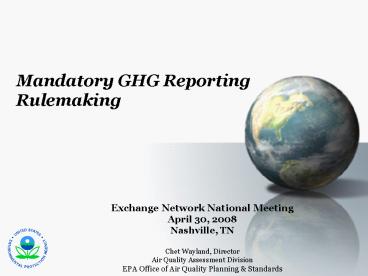Mandatory GHG Reporting Rulemaking - PowerPoint PPT Presentation
1 / 17
Title:
Mandatory GHG Reporting Rulemaking
Description:
not less than $3,500,000 shall be provided for activities to ... Protocols- e.g., API Compendium, CSI Protocol (cement), International Aluminum Institute ... – PowerPoint PPT presentation
Number of Views:32
Avg rating:3.0/5.0
Title: Mandatory GHG Reporting Rulemaking
1
Mandatory GHG ReportingRulemaking
- Exchange Network National Meeting
- April 30, 2008
- Nashville, TN
- Chet Wayland, Director
- Air Quality Assessment Division
- EPA Office of Air Quality Planning Standards
2
Outline
- Appropriations Language
- Authority
- Purpose and Scope
- Data systems
- Timing and Process
- Summary
3
Appropriations Language
- FY2008 Consolidated Appropriations Act
- not less than 3,500,000 shall be provided for
activities to develop and publish a draft rule
not later than 9 months after the date of
enactment of this Act, and a final rule not later
than 18 months after the date of enactment of
this Act, to require mandatory reporting of
greenhouse gas emissions above appropriate
thresholds in all sectors of the economy - Accompanying Explanatory Statement
- The Agency shall "use its existing authority
under the Clean Air Act" to develop a mandatory
GHG reporting rule. "The Agency is further
directed to include in its rule reporting of
emissions resulting from upstream production and
downstream sources, to the extent that the
Administrator deems it appropriate. The
Administrator shall determine appropriate
thresholds of emissions above which reporting is
required, and how frequently reports shall be
submitted to EPA. The Administrator shall have
discretion to use existing reporting requirements
for electric generating units under Section 821
of the Clean Air Act...."
4
Legal Authorities
- Sections 114 and 208 of the CAA allow for data
collection and measurement and recordkeeping from
stationary or mobile related sources - Appropriations language provides EPA with 3.5
million in FY 2008 to develop proposed and final
rules
5
Purpose and Scope
- Objective(s) of the Program to provide data
that will inform and support development of
national climate policy - Scope of Coverage
- Define gases- to require mandatory reporting of
greenhouse gas emissions - CO2, CH4, N2O, HFC, PFC, SF6
- Both upstream and downstream sources- The Agency
is further directed to include in its rule
reporting of emissions resulting from upstream
production and downstream sources - Upstream fuel and chemical producers/importers
- Downstream large industrial facilities
6
U.S. 2005 GHG Emissions
7
Purpose and Scope cont.
- Areas of flexibility
- Emissions threshold The Administrator shall
determine appropriate thresholds of emissions
above which reporting is required - Frequency of Reporting and how frequently
reports shall be submitted to EPA - Methods
- The Administrator shall have discretion to use
existing reporting requirements for electric
generating units under Section 821 of the Clean
Air Act - Will build on methods from existing mandatory and
voluntary reporting systems - Federal reporting programs- e.g., Title IV,
Climate Leaders, 1605(b) - State Programs- e.g., California, The Climate
Registry, RGGI, other state programs - Corporate Programs- e.g., WRI/WBCSD
- Industry Protocols- e.g., API Compendium, CSI
Protocol (cement), International Aluminum
Institute
8
Data Systems
- There are several current state and federal data
systems for emissions reporting and fossil fuel
data (e.g., NEI, Acid Rain emissions tracking
system, etc.) - EPA staff are coordinating with states, the
Climate Registry, and the Exchange Network to
develop a single reporting format for greenhouse
gases (a data exchange standard) - A single reporting format would not compromise
individual programs and would reduce the burden
of reporting for all
9
Timing and Process
- Proposed rule by September 2008, final rule by
June 2009 - An ambitious timetable but we will work towards
these deadlines - EPA will involve agency and interagency expertise
- Have already worked extensively with interagency
counterparts on measurement and reporting issues
(e.g., US GHG inventory, IPCC guidelines) - EPA welcomes stakeholder input and plans to reach
out to stakeholders through information sharing
sessions
10
Reporting Rule Summary
- EPA is prepared to implement GHG reporting
- Existing methods in many sectors
- Significant expertise in all sectors
- Infrastructure to collect/house comprehensive
emissions data - EPA will build on existing approaches and engage
stakeholders throughout to answer key technical
issues and craft a viable proposed and final
rule.
11
GHG Emissions vs. other traditional Emissions
Sources
Mobile NonRoad Sources
NonPoint Sources
Point Sources
Mobile OnRoad Sources
12
Why Coordinate?
- Comprehensive AQ management
- Consistent and complete impact of sources
- Reduce burden on reporting entities
- Leverage Resources
13
Common Elements
- Sources of emissions
- Methods for measuring/estimating emissions
- QA/Validation
14
Differences
- Money associated with emissions
- Regulatory approach
- Pollutants
- Some new sources
- Scale
- Life cycle perspective
- Organizational issues
- Terminology
15
Current Coordination Efforts
- Development of common infrastructure
- EPA working with Climate Registry and the
Exchange Network on common reporting format
(NEI/AirDEx combination) ready June 2008 - EPA evaluating existing data systems for
acquisition and distribution - Mandatory Federal reporting
- EPA looking to leverage off existing emission
reporting requirements - State reporting initiatives
- EPA evaluating state reporting initiatives (e.g.,
Title V)
16
Possible GHG Emissions Data Flows
- GHG mandatory reporting rule
- Industry-to-EPA reporting
- State-to-EPA reporting
- The Climate Registry
- Industry-to-TCR reporting
- State-to-TCR reporting
- State reporting rules
- Industry-to-State reporting (at least 10 states
currently) - Voluntary reporting
- State-to-EPA reporting (25 states)
17
Issues
- Is it worth the effort to coordinate?
- Who reports to who?
- Where to coordinate
- Front end?
- Back end?
- Roles
- Federal
- State
- Others (e.g., The Climate Registry)



















![Critical Incident Reporting System [CIRS] PowerPoint PPT Presentation](https://s3.amazonaws.com/images.powershow.com/5580970.th0.jpg?_=201410200211)











